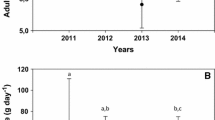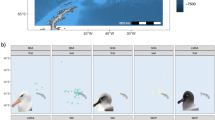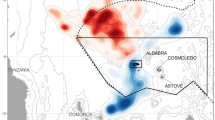Abstract
Despite the recent burgeoning in predator tracking studies, few report on seabird activity patterns, despite the potential to provide important insights into foraging ecology and distribution. In the first year-round study for any small petrel, we examined the activity patterns of the white-chinned petrel Procellaria aequinoctialis based on data from combination geolocator-immersion loggers deployed on adults at South Georgia. The petrels were highly nocturnal, flying for greater proportions of darkness than any large procellarid studied so far, except the light-mantled albatross Phoebetria palpebrata. Flight bout durations were short compared with other species, suggesting a dominant foraging mode of small-scale searching within large prey patches. When migrating, birds reduced the proportion of time on the water and increased flight bout duration. Activity patterns changed seasonally: birds flew least during the nonbreeding period, and most frequently during chick-rearing in order to meet higher energy demands associated with provisioning offspring. The degree of their response to moonlight was also stage dependent (greatest in nonbreeding, and weakest in incubating birds), a trait potentially shared by other nocturnal petrels which will have repercussions for feeding success and prey selection. For the white-chinned petrel, which is commonly caught in longline fisheries, these results can be used to identify periods when birds are most susceptible to bycatch, and therefore when use of mitigation and checking for compliance is critical.


Similar content being viewed by others
References
Barnes KN, Ryan PG, Boix-Hinzen C (1997) The impact of the hake Merluccius spp. longline fishery off South Africa on Procellariiform seabirds. Biol Conserv 82:227–234
Berrow SD, Wood AG, Prince PA (2000a) Foraging location and range of White-chinned Petrels Procellaria aequinoctialis breeding in the South Atlantic. J Avian Biol 31:303–311
Berrow SD, Croxall JP, Grant SD (2000b) Status of white-chinned petrels Procellaria aequinoctialis Linnaeus 1758, at Bird Island, South Georgia. Antarct Sci 12:399–405
Bridge ES (2006) Influences of morphology and behavior on wing-molt strategies in seabirds. Mar Ornithol 34:7–19
Catard A, Weimerskirch H, Cherel Y (2000) Exploitation of distant Antarctic waters and close shelf-break waters by white-chinned petrels rearing chicks. Mar Ecol Prog Ser 194:249–261
Catry P, Phillips RA, Phalan B, Silk JRD, Croxall JP (2004) Foraging strategies of grey-headed albatrosses Thalassarche chrysostoma: integration of movements, activity and feeding events. Mar Ecol Prog Ser 280:261–273
Catry T, Ramos JA, Le Corre M, Phillips RA (2009) Movements, at-sea distribution and behaviour of a tropical pelagic seabird: the wedge-tailed shearwater in the western Indian Ocean. Mar Ecol Prog Ser 391:231–242
Delord K, Gasco N, Weimerskirch H, Barbraud C, Micol T (2005) Seabird mortality in the Patagonian toothfish longline fishery around Crozet and Kerguelen Islands, 2001–2003. CCAMLR Sci 12:53–80
Gandini P, Frere E (2006) Spatial and temporal patterns in the bycatch of seabirds in the Argentinian longline fishery. Fish Bull 104:482–485
Gómez Laich A, Favero M (2007) Spatio-temporal variation in mortality rates of White-chinned Petrels Procellaria aequinoctialis interacting with longliners in the south-west Atlantic. Bird Conserv Int 17:359–366
González-Solís J, Croxall JP, Briggs DR (2002) Activity patterns of giant petrels. Macronectes spp., using different foraging strategies. Mar Biol 140:197–204
González-Zevallos D, Yorio P (2006) Seabird use of discards and incidental captures at the Argentine hake trawl fishery in the Golfo San Jorge, Argentina. Mar Ecol Prog Ser 316:175–183
Guilford T, Meade J, Willis J, Phillips RA, Boyle D, Roberts S, Collett M, Freeman R, Perrins CM (2009) Migration and stopover in a small pelagic seabird, the Manx shearwater Puffinus puffinus: insights from machine learning. Proc Roy Soc Lond B 276:1215–1223
Harper PC (1987) Feeding behaviour and other notes on 20 species of Procellariiformes at sea. Notornis 34:169–192
Hedd A, Gales R, Brothers N (2001) Foraging strategies of shy albatross Thalassarche cauta breeding at Albatross Island, Tasmania, Australia. Mar Ecol Prog Ser 224:267–282
Horning M, Trillmich F (1999) Lunar cycles in diel prey migrations exert a stronger effect on the diving of juveniles than adult Galápagos fur seals. Proc Roy Soc Lond B 266:1127–1132
Huin N (1994) Diving depths of white-chinned petrels. The Condor 96:1111–1113
Landers TJ, Rayner MJ, Phillips RA, Hauber ME (in press) Dynamics of seasonal movements by a trans-pacific migrant, the Westland petrel. The Condor
Mackley EK, Phillips RA, Silk JRD, Wakefield ED, Afanasyev V, Fox JW, Furness RW (2010) Free as a bird? Activity patterns of albatrosses during the nonbreeding period. Mar Ecol Prog Ser 406:291–303
Marchant S, Higgins PJ (1990) Handbook of Australian, New Zealand and Antarctic birds, vol 1: Ratites to ducks. Oxford University Press, Melbourne
Martin AR, Poncet S, Barbraud C, Foster E, Fretwell P, Rothery P (2009) The white-chinned petrel (Procellaria aequinoctialis) on South Georgia: population size, distribution and global significance. Polar Biol 32:655–661
Moreno CA, Rubilar PS, Marschoff E, Benzaquen L (1996) Factors affecting the incidental mortality of seabirds in the Dissostichus eleginoides fishery in the southwest Atlantic (subarea 48.3, 1995 season). CCAMLR Sci 3:79–91
Nevitt G, Reid K, Trathan P (2004) Testing olfactory foraging strategies in an Antarctic seabird assemblage. J Exp Biol 207:3537–3544
Pennycuick CJ (1987) Flight of seabirds. In: Croxall JP (ed) Seabirds: feeding ecology and role in marine ecosystems. Cambridge University Press, Cambridge, pp 43–62
Petersen SL, Nel DC, Ryan PG, Underhill LG (2008a) Understanding and mitigating vulnerable bycatch in southern African trawl and longline fisheries. WWF South Africa Report Series—2008/Marine/002
Petersen SL, Phillips RA, Ryan PG, Underhill LG (2008b) Albatross overlap with fisheries in the Benguela Upwelling System: implications for conservation and management. Endang Species Res 5:117–127
Phalan B, Phillips RA, Silk JRD, Afanasyev V, Fukuda A, Fox J, Catry P, Higuchi H, Croxall JP (2007) Foraging behaviour of four albatross species by night and day. Mar Ecol Prog Ser 340:271–286
Phillips RA, Croxall JP, Xavier JC (2003) Effects of satellite transmitters on albatrosses and petrels. Auk 120:1082–1090
Phillips RA, Silk JRD, Croxall JP, Afanasyev V (2004) Accuracy of geolocation estimates for flying seabirds. Mar Ecol Prog Ser 266:265–272
Phillips RA, Silk JRD, Croxall JP (2005) Foraging and provisioning strategies of the light-mantled sooty albatross at South Georgia: competition and co-existence with sympatric pelagic predators. Mar Ecol Prog Ser 285:259–270
Phillips RA, Silk JRD, Croxall JP, Afanasyev V (2006) Year-round distribution of white-chinned petrels from South Georgia: relationships with oceanography and fisheries. Biol Conserv 129:336–347
Phillips RA, Catry P, Silk JRD, Bearhop S, McGill R, Afanasyev Y, Strange IJ (2007) Movements, winter distribution and activity patterns of Falkland and brown skuas: insights from loggers and isotopes. Mar Ecol Prog Ser 345:281–291
Phillips RA, Croxall JP, Silk JRD, Briggs DR (2008) Foraging ecology of albatrosses and petrels from South Georgia: two decades of insights from tracking technologies. Aquat Conserv: Mar Freshwat Ecosyst 17:S6–S21
Pinheiro JC, Bates DM (2000) Mixed effects models in S and S-PLUS. Springer, New York
Prince PA, Huin N, Weimerskirch H (1994) Diving depths of albatrosses. Antarct Sci 6:353–354
Rayner MJ, Hauber ME, Clout MN, Seldon DS, Van Dijken S, Bury S, Phillips RA (2008) Foraging ecology of Cook’s petrel Pterodroma cookii during the austral breeding season: a comparison of its two populations. Mar Ecol Prog Ser 370:271–284
Rodhouse PG, Symon C, Hatfield EMC (1992) Early life cycle of cephalopods in relation to the major oceanographic features of the southwest Atlantic Ocean. Mar Ecol Prog Ser 89:183–195
Shaffer SA, Costa DP, Weimerskirch H (2003) Foraging effort in relation to the constraints of reproduction in free-ranging albatrosses. Funct Ecol 17:66–74
Shaffer SA, Weimerskirch H, Scott D, Pinaud D, Thompson DR, Sagar PM, Moller H, Taylor GA, Foley DG, Tremblay Y, Costa DP (2009) Spatio-temporal habitat use by breeding sooty shearwaters Puffinus griseus. Mar Ecol Prog Ser 391:209–220
Venables WN, Ripley BD (2002) Modern applied statistics with S, 4th edn. Springer, New York
Wakefield ED, Phillips RA, Matthiopoulos J (2009) Quantifying habitat use and preferences of pelagic seabirds using individual movement data: a review. Mar Ecol Prog Ser 391:165–182
Weimerskirch H, Guionnet T (2002) Comparative activity pattern during foraging of four albatross species. Ibis 144:40–50
Weimerskirch H, Wilson RP, Lys P (1997) Activity pattern of foraging in the wandering albatross: a marine predator with two modes of prey searching. Mar Ecol Prog Ser 151:245–254
Weimerskirch H, Catard A, Prince PA, Cherel Y, Croxall JP (1999) Foraging white-chinned petrels Procellaria aequinoctialis at risk: from the tropics to Antarctica. Biol Conserv 87:273–275
Weimerskirch H, Guionnet T, Martin J, Shaffer SA, Costa DP (2000a) Fast and fuel efficient? Optimal use of wind by flying albatrosses. Proc Roy Soc Lond B 267:1869–1874
Weimerskirch H, Capdeville D, Duhamel G (2000b) Factors affecting the number and mortality of seabirds attending trawlers and long-liners in the Kerguelen area. Polar Biol 23:236–249
Acknowledgments
This research represents a contribution to the British Antarctic Survey Ecosystems Programme. We are very grateful to the many field workers for their help with deploying and retrieving data loggers, and to J.P. Croxall for supporting the procellariiform research at Bird Island.
Author information
Authors and Affiliations
Corresponding author
Additional information
Communicated by M. E. Hauber.
Rights and permissions
About this article
Cite this article
Mackley, E.K., Phillips, R.A., Silk, J.R.D. et al. At-sea activity patterns of breeding and nonbreeding white-chinned petrels Procellaria aequinoctialis from South Georgia. Mar Biol 158, 429–438 (2011). https://doi.org/10.1007/s00227-010-1570-x
Received:
Accepted:
Published:
Issue Date:
DOI: https://doi.org/10.1007/s00227-010-1570-x




